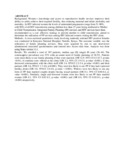Integration and utilization of family planning services in a HIV clinic in Nairobi, Kenya

View/
Date
2015-07Author
Njugun, E
Ilovi, S
Mutai, K.
Njoroge, P.
Muiruri, P
Kinuthia, J
Type
PresentationLanguage
enMetadata
Show full item recordAbstract
Background: Women’s knowledge and access to reproductive health services improves
their ability to safely achieve their required fertility, thus reducing maternal and infant morbidity
and mortality. In HIV infected women the levels of unintended pregnancies range from 51-90%,
with 90% of all HIV transmission among children less than 15 years being attributed to Mother
to Child Transmission. Integrated Family Planning (FP) services and HIV services have been
recommended as a cost effective strategy to prevent mother to child transmission.
We aimed to determine the utilization of FP services among HIV Infected women visiting the
HIV clinic.
Methods: A cross-sectional quantitative study involving randomly selected HIV positive
females was conducted in Kenyatta National Hospital, Nairobi, Kenya. The outcome variable
was the utilization of family planning services. Data were acquired by one to one interviewer
administered structured questionnaires and entered into Access data base. Analysis was done
using Stata version 11.1.
Results: We enrolled a total of 387 patients, median age (IQ range) 40 years (36-44). The
contraceptive prevalence was 53% with an unmet need of family planning of 38.5%. Patients
were more likely to use family planning if they were married, (OR 12.9, 95% CI 6.5-25.7, pvalue
<0.01), if condoms were offered at the clinic (OR 3.2, 95% CI 1.9-5.4, p-value <0.001), if
they discussed contraception with the clinic staff (OR 3.4, 95%CI 2.2-5.4, p-value <0.001) and
their partners (OR 2.6, 95%CI 1.7-4.0, p<0.001). They were less likely to use FP if they had
expressed fertility desire (OR 3.0, 95%CI 1.8-4.8, p-value < 0.001). Widows were less likely
to use any form of FP than married couples despite having sexual partners (OR 0.1, 95% CI
0.04-0.2, p-value <0.001). Similarly, single and divorced women were less likely to use FP than
married women (OR 0.1, 95% CI 0.03-0.3, p-value <0.001) and (OR 0.4, 95% CI 0.02-0.1,
p-value <0.001) respectively....
